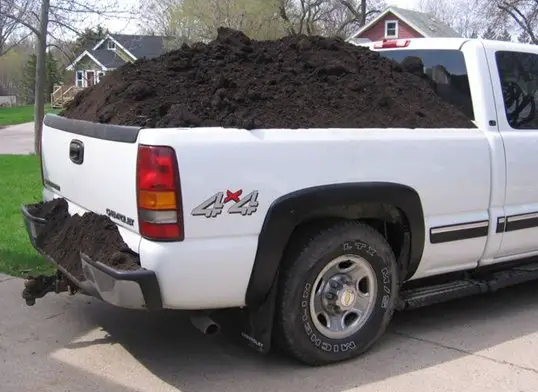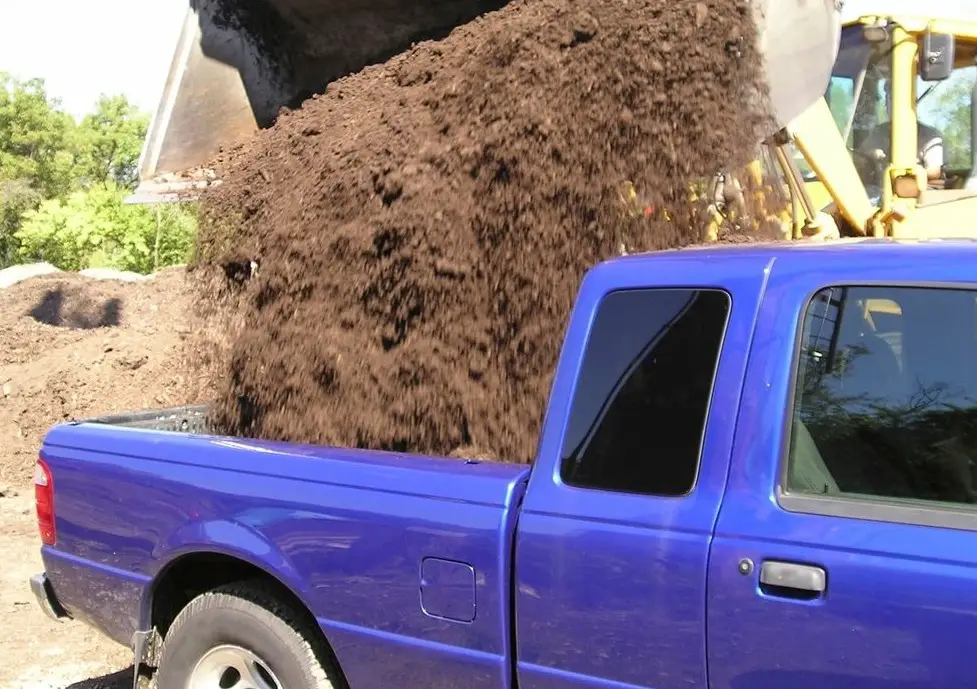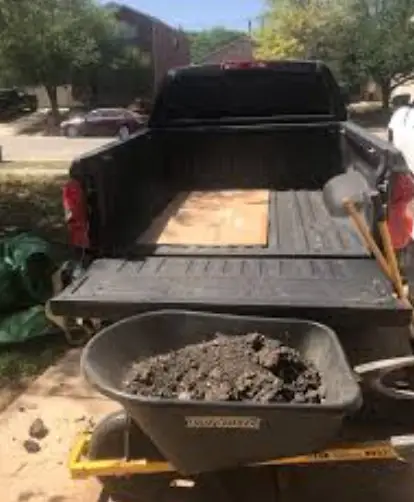If you’re planning on using a half-ton pickup truck to haul dirt, you might be wondering just how much weight it can handle. After all, you don’t want to overload the truck and risk damaging it or causing an accident on the road. So, how much dirt can a half-ton truck carry?
You can fit up to 2 yards of dirt by volume in the bed of an average half-ton pickup truck, but you can only fit 1 to 1-½ cubic yards of dirt without exceeding the truck’s payload capacity.
Note that the weight of the dirt can vary depending on the type of soil you’re hauling, and you’ll need to make sure you don’t exceed the payload capacity of your specific truck. We’ll go into everything you need to know about hauling dirt in a ½-ton truck in this guide.
Key Takeaways:
- The amount of dirt a half-ton truck can carry depends on its payload capacity, which is typically between 1,200 to 2,200 lbs. It’s important to not exceed this limit, as it can be dangerous and cause damage to your vehicle.
- The weight of the dirt can vary depending on the type of soil you’re hauling, and you’ll need to make sure you don’t exceed the payload capacity of your specific truck. A cubic yard of topsoil, for example, can weigh between 1,000 to 3,000 lbs depending on the organic content of the topsoil.
- When loading a half-ton truck with dirt, it’s important to distribute the load evenly, secure the load, and watch your speed. Exceeding the payload capacity, uneven weight distribution, or driving at high speeds with a loaded truck can be dangerous and cause accidents on the road.
How Much Dirt Can a Half-Ton Truck Carry?

If you’re planning on hauling dirt with your half-ton pickup truck, you might be wondering how much weight it can handle.
While a half-ton truck can fit 2 yards of dirt in the bed, that will easily exceed the payload capacity of the truck and cause damage.
Here’s how much dirt a half-ton pickup can actually carry:
- Dirt / Topsoil: 1-1.5 cubic yards
- Sand: 3/4-1 cubic yard
- Gravel: ¾-1 cubic yard
- Mulch: 2-3 cubic yards
Here are some things to keep in mind:
Payload Capacity of a Half-Ton Truck
The payload capacity of a half-ton pickup truck is typically between 1,200 to 2,200 lbs.
This weight includes the weight of the passengers, cargo, and anything else that you’re carrying in the truck bed.
It’s important to not exceed this limit, as it can be dangerous and cause damage to your vehicle.
Weight Of Common Materials
The amount of dirt you can haul in your half-ton truck depends on the weight of the material.
For example, 1 cubic yard of topsoil can weigh around 2,100 lbs, while 1 cubic yard of sand or gravel can weigh around 2,700 lbs. Here’s a table to give you an idea of how much weight common materials can add up to:
| Material | Weight per Cubic Yard |
| Topsoil | 2,100 lbs |
| Sand | 2,600 lbs – 3,200 lbs |
| Gravel | 2,400 lbs – 2,900 lbs |
| Mulch | 800 lbs -1,000 lbs |
Keep in mind that these weights are approximate and can vary depending on the moisture content and density of the material.
Volume Of Dirt
In terms of volume, a half-ton truck can typically haul up to 2 cubic yards of soil or 1.5 cubic yards of sand or gravel. This is assuming that the truck bed is not filled to the brim and that the weight limit is not exceeded.
So How Much Dirt Can a Half-Ton Pickup Really Carry?
If you’re considering not exceeding the actual payload of your truck, then a ½ ton pickup
Comparing Half-Ton Trucks

If you’re in the market for a half-ton truck to haul dirt, it’s essential to know the payload capacity of the most common models. The payload capacity is the maximum amount of weight that the truck can carry, including passengers, cargo, and the weight of the vehicle itself. Here’s a comparison of the most popular half-ton trucks on the market today.
Payload Capacity Chart for Common Half-Ton Trucks
| Truck Model | Payload Capacity |
| Ford F150 | 1,985 – 3,325 lbs |
| Chevy Silverado 1500 | 1,590 – 2,290 lbs |
| GMC Sierra 1500 Toyota Tundra Nissan Titan | 1,750 – 2,240 lbs Up to 1,940 lbs 1,356 – 1,697 lbs |
As you can see from the chart, the Ford F150 has the highest payload capacity of the three trucks. However, the other major manufacturer’s half-ton offerings are not far behind and can still handle a substantial amount of weight.
Engine and Transmission Impact on Payload
The engine and transmission of a half-ton truck can also impact its payload capacity. A more powerful engine and transmission can typically handle more weight.
For example, the Ford F150 comes with several engine options, including a 3.3L V6, a 2.7L EcoBoost V6, a 5.0L V8, and a 3.5L EcoBoost V6.
The 3.5L EcoBoost V6 is the most powerful engine and can handle the most weight.
In contrast, the Chevy Silverado 1500 and GMC Sierra 1500 come with a 4.3L V6, a 5.3L V8, and a 6.2L V8 engine.
The 6.2L V8 is the most powerful engine and can handle the most weight.
Wwhen comparing half-ton trucks for hauling dirt, it’s essential to consider the payload capacity and the engine and transmission options.
The Ford F150 has the highest payload capacity, but the Chevy Silverado 1500 and GMC Sierra 1500 are not far behind.
Additionally, the engine and transmission options can impact the truck’s ability to handle weight, so it’s crucial to choose the right combination for your needs.
Understanding Truck Weight Terminology

If you’re in the market for a pickup truck, you’ll likely come across terms like “payload capacity” and “curb weight.”
Understanding these terms is crucial when it comes to determining how much dirt or other cargo your truck can carry.
Here’s a breakdown of some common weight-related terms you’ll come across:
- Curb Weight: This is the weight of the truck without any passengers or cargo. It includes the weight of the vehicle’s standard equipment, fuel, and other fluids. Curb weight is important to know because it affects the truck’s payload capacity.
- Payload Capacity: This is the weight of the cargo and passengers that the truck can safely carry. It’s calculated by subtracting the curb weight from the truck’s Gross Vehicle Weight Rating (GVWR). Keep in mind that the payload capacity includes the weight of any passengers, tools, or other items you’re carrying in addition to the dirt.
- Gross Vehicle Weight Rating (GVWR): This is the maximum weight that the truck can safely carry, including passengers, cargo, and the weight of the vehicle itself. Exceeding the GVWR can be dangerous and cause damage to the vehicle.
When it comes to carrying dirt in a 1/2 ton pickup truck, the payload capacity is what you need to pay attention to.
As we mentioned earlier, the average 1/2 ton pickup truck can carry between 1,200 to 2,200 pounds.
Keep in mind that the weight of the dirt can vary depending on the type of soil and moisture content.
A cubic yard of topsoil, for example, can weigh between 1,000 to 3,000 lbs depending on the organic content of the topsoil.
One-Ton Trucks Vs Half-Ton Trucks

If you’re looking for a pickup truck to haul dirt, you’ll likely come across the terms “one-ton truck” and “half-ton truck.” But what do these terms mean, and how do they compare when it comes to hauling capacity?
First, let’s define what we mean by “one-ton truck” and “half-ton truck.” These terms are based on the weight of the truck’s payload capacity, not the actual weight of the truck itself.
A one-ton truck can carry up to 2,000 pounds of payload, while a half-ton truck can carry up to 1,000 pounds of payload.
One-ton trucks are classified as heavy-duty trucks and are typically used for commercial purposes, such as hauling construction materials or towing heavy equipment.
They are larger and more powerful than half-ton trucks, with stronger frames, axles, and suspension systems.
Half-ton trucks, on the other hand, are classified as light-duty trucks and are more commonly used for personal or recreational purposes, such as hauling furniture or towing a boat.
They are smaller and more fuel-efficient than one-ton trucks, with more comfortable interiors and better handling on the road.
When it comes to hauling dirt, both one-ton and half-ton trucks can get the job done.
A one-ton truck will typically have a larger bed and more powerful engine, which means it can carry more dirt and haul it over longer distances without straining the engine.
Ultimately, the choice between a one-ton and half-ton truck will depend on your specific needs and budget. If you’re hauling dirt on a regular basis or need to tow heavy loads, a one-ton truck may be the better choice.
If you’re just looking for a versatile and comfortable pickup for everyday use, a half-ton truck may be more practical.
Safety Considerations When Loading a Half-Ton Truck
Loading a half-ton truck with dirt can be a simple task, but it can also be dangerous if not done correctly. Here are some safety considerations you should keep in mind when loading your truck:
Know Your Truck’s Safe Payload Capacity
Before loading your truck, it is important to know its safe payload capacity. As per the search results, a half-ton pickup truck can carry between 1,200 to 2,200 lbs of weight.
Exceeding this capacity can cause damage to your truck’s suspension, brakes, and transmission, which can result in costly repairs.
Distribute the Load Evenly
When loading your truck, it is essential to distribute the load evenly to maintain stability and prevent accidents.
Uneven weight distribution can cause the truck to sway or tip over, especially during sharp turns or sudden stops.
To ensure proper weight distribution, place heavier items in the center of the truck bed and lighter items towards the edges.
Secure the Load
Securing the load is crucial to prevent it from shifting or falling off the truck bed during transit.
Use ropes, straps, or bungee cords to tie down the load securely.
Make sure the load is tightly secured from all sides, including the front, back, and sides of the truck bed.
Watch Your Speed
Driving at high speeds with a loaded truck can be dangerous.
The added weight can affect your truck’s braking distance and stability, making it difficult to control.
To ensure your safety, drive at a moderate speed and maintain a safe distance from other vehicles on the road.
Be Mindful of Other Cars
When driving a loaded truck, you need to be mindful of other cars on the road. The added weight can affect your truck’s maneuverability, making it difficult to make sudden lane changes or turns.
Always use your turn signals and check your blind spots before changing lanes or turning.
By following these safety considerations, you can ensure a safe and hassle-free experience when loading your half-ton truck with dirt.
Check out our other helpful hauling guides while you’re here:

